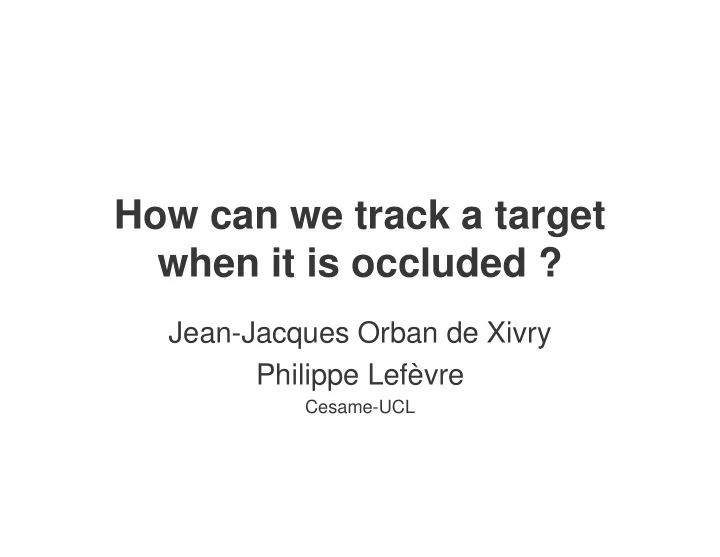

How can we track a target when it is occluded ? Jean-Jacques Orban de Xivry Philippe Lefèvre Cesame-UCL
Is this yours ??
What happens with his car ???
Driving around in the country side
Eye movements Saccades Latency Position error
Eye movements bis Smooth pursuit Retinal slip
Interaction between saccades and pursuit
Saccade programming Position Time 0 . 9 0 . 9 0 . 1 S AMP PE S AMP PE RS = ⋅ = ⋅ + ⋅
Occlusions
Typical example
Tracking the invisible path
Conclusion : smooth pursuit • In one dimension, horizontal eye velocity decreases • Vectorial velocity decreases after occlusion onset but… • H and V components of eye velocity remain tightly coupled and can accelerate
Saccades During visually guided pursuit : correcting the position error During occlusions : target is invisible
Saccade programmation Visually guided saccades : S AMP 0 . 1 0 . 9 PE 0 . 1 RS = + ⋅ + ⋅ Predictive saccades (target is invisible) : S AMP 0 . 1 0 . 15 PE * 0 . 2 RS * = + ⋅ + ⋅
Conclusion : saccades (1) • In contrast with visually-guided saccades, predictive saccades do not correct position error • They are driven by the velocity error.
Saccade latency
Saccade latencies
First saccades
Ensuing saccades Inter-saccadic time
Ensuing saccades
Conclusion : saccades (2) • Saccadic system seems to be always active. As soon as a saccade is over, a decision process is reinitiated for the next saccade
Intro to modeling 0 . 1 0 . 9 0 . 1 S AMP PE RS = + ⋅ + ⋅
Modeling during occlusion S AMP 0 . 1 0 . 15 PE 0 . 2 RS = + ⋅ + ⋅
LATER model always on
"Behind the trees" • H and V components remain coupled • Saccades do not correct for position error • Position error plays a minor role in the programming of saccades but velocity error has a major one • Saccadic system is always active and saccadic latency can be explained by a cascade of LATER processes
Wake up now…. It's finished…
Recommend
More recommend